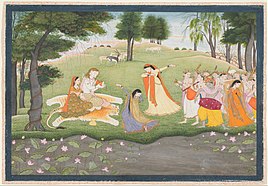Our website is made possible by displaying online advertisements to our visitors.
Please consider supporting us by disabling your ad blocker.
Kama
| Part of a series on |
| Hinduism |
|---|
 |
| Part of a series on |
| Love |
|---|
Kama (Sanskrit: काम, IAST: kāma) is the concept of pleasure, enjoyment and desire in Hinduism, Buddhism, Jainism, and Sikhism. It can also refer to "desire, wish, longing" in Hindu, Buddhist, Jain, and Sikh literature.[2][3][4] However, the term is also used in a technical sense to refer to any sensory enjoyment, emotional attraction or aesthetic pleasure experienced in connection with the arts, dance, music, painting, sculpture, and nature.[1][5]
In contemporary literature kama is often used to connote sexual desire and emotional longing,[3][4][6] but the ancient concept is more expansive, and broadly refers to any desire, wish, passion, pleasure, or enjoyment of art and beauty, the aesthetic, enjoyment of life, affection, love and connection, and enjoyment of love with or without sexual connotations.[3][7]
In Hindu thought, kama is one among the three items of the trivarga and is one of the four Purusharthas, which are the four beneficial domains of human endeavor.[8][9] In Hinduism it is considered an essential and healthy goal of human life to pursue Kama without sacrificing the other three Purusharthas: Dharma (virtuous, ethical, moral life), Artha (material needs, income security, means of life) and Moksha (liberation, release, self-realization).[10][8][11][12] In Buddhism and Jainism kama is to be overcome in order to obtain the goal of liberation from rebirth. But while kama is viewed as an obstacle for Buddhist and Jain monks and nuns, it is recognized as legitimate domain of activity for laity.[13]
- ^ a b See:
- Kate Morris (2011), The Illustrated Dictionary of History, ISBN 978-8189093372, pp 124;
- Robert E. Van Voorst, RELG: World, Wadsworth, ISBN 978-1-111-72620-1, pp 78
- ^ Monier Williams, काम, kāma Archived 2017-10-19 at the Wayback Machine Monier-Williams Sanskrit English Dictionary, pp 271, see 3rd column
- ^ a b c Macy, Joanna (August 1975). "The Dialectics of Desire". Numen. 22 (2). Leiden: Brill Publishers: 145–160. doi:10.1163/156852775X00095. eISSN 1568-5276. ISSN 0029-5973. JSTOR 3269765. S2CID 144148663.
- ^ a b Lang, Karen C. (June 2015). Mittal, Sushil (ed.). "When the Vindhya Mountains Float in the Ocean: Some Remarks on the Lust and Gluttony of Ascetics and Buddhist Monks". International Journal of Hindu Studies. 19 (1/2). Boston: Springer Verlag: 171–192. doi:10.1007/s11407-015-9176-z. eISSN 1574-9282. ISSN 1022-4556. JSTOR 24631797. S2CID 145662113.
- ^ Cite error: The named reference
rp10was invoked but never defined (see the help page). - ^ James Lochtefeld (2002), The Illustrated Encyclopedia of Hinduism, Volume 1, Rosen Publishing, New York, ISBN 0-8239-2287-1, page 340.
- ^ Lorin Roche. "Love-Kama". Archived from the original on 20 April 2017. Retrieved 15 July 2011.
- ^ a b Salagame, Kiran K. (2013). "Well-being from the Hindu/Sanātana Dharma Perspective". In Boniwell, Ilona; David, Susan A.; Ayers, Amanda C. (eds.). Oxford Handbook of Happiness. Oxford: Oxford University Press. doi:10.1093/oxfordhb/9780199557257.013.0029. ISBN 9780199557257. S2CID 148784481.
- ^ Olivelle, Patrick (2019). "From trivarga to puruṣārtha". Journal of the American Oriental Society. 139 (2): 381. ISSN 2169-2289.
- ^ Zysk, Kenneth (2018). "Kāma". In Basu, Helene; Jacobsen, Knut A.; Malinar, Angelika; Narayanan, Vasudha (eds.). Brill's Encyclopedia of Hinduism. Vol. 7. Leiden: Brill Publishers. doi:10.1163/2212-5019_BEH_COM_2050220. ISBN 978-90-04-17641-6. ISSN 2212-5019.
- ^ The Hindu Kama Shastra Society (1925), The Kama Sutra of Vatsyayana, University of Toronto Archives, pp. 8
- ^ see:
- A. Sharma (1982), The Puruṣārthas: a study in Hindu axiology, Michigan State University, ISBN 9789993624318, pp 9-12; See review by Frank Whaling in Numen, Vol. 31, 1 (Jul., 1984), pp. 140-142;
- A. Sharma (1999), The long uruṣārthas: An Axiological Exploration of Hinduism Archived 2020-12-29 at the Wayback Machine, The Journal of Religious Ethics, Vol. 27, No. 2 (Summer, 1999), pp. 223-256;
- Chris Bartley (2001), Encyclopedia of Asian Philosophy, Editor: Oliver Learman, ISBN 0-415-17281-0, Routledge, Article on Purushartha, pp 443
- ^ Fiorucci, Anthony (2023). Guilty pleasures: kāma in ancient India and the Pali Vinaya. Uppsala: Uppsala University. ISBN 978-91-506-3025-1.
Previous Page Next Page









